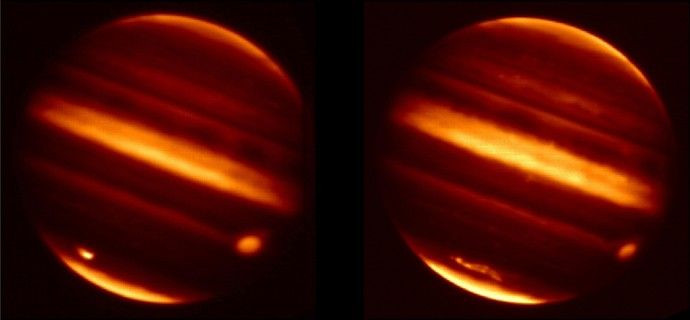Huge asteroid strike on Jupiter stokes fears of 'complex and violent’ solar system

A huge asteroid the size of the Titanic has struck Jupiter, leaving a hole as large as the Pacific Ocean and causing temperatures to rise by 4 degrees Kelvin, scientists have confirmed. The July 2009 crash, which released the equivalent of five gigatons of TNT, had perplexed astronomers. But with the new findings, published in the journal Icarus, the mystery behind the huge scar on Jupiter is resolved.
Britain's Daily Mail newspaper quoted researchers as saying the massive asteroid strike on Jupiter reminded that the solar system is a ‘complex and violent’ place.
Significantly, the crashing of the 500-meter-long rock was the first asteroid strike on the planet confirmed by scientists. Anthony Wesley, an Australian amateur astronomer, had been credited with first noticing the impact of the asteroid strike on Jupiter in July 2009.
Though the studies published in Icarus confirm the asteroid impact, the Hubble site had said last year the impact was likely caused by an asteroid. Without warning, a mystery object struck Jupiter on July 19, 2009, leaving a dark bruise the size of the Pacific Ocean. The spot first caught the eye of an amateur astronomer in Australia, and soon, observatories around the world, including NASA's Hubble Space Telescope, were zeroing in on the unexpected blemish, a report on the Hubble site said in June 2010.
In a surprising coincidence, a similar impact on Jupiter occurred exactly the same week 15 years ago -- in July 1994 -- when more than 20 pieces of Comet P/Shoemaker-Levy 9 (SL9) plunged into Jupiter's atmosphere, according to the hubblesite.
The report said the 2009 strike, which created an elongated, dark spot on Jupiter, was equal to the explosion of a few thousand standard nuclear bombs.
The unexpected blemish was created when an unknown object plunged into Jupiter and exploded, scattering debris into the giant planet's cloud tops. The strike was equal to the explosion of a few thousand standard nuclear bombs.
The Shoemaker-Levy 9 strike in 1994 had sparked intrigue around the world as it was the first time a comet was observed orbiting a planet, according to the Daily Mail report. Shoemaker-Levy 9 had been snared by Jupiter’s gravitational pull.
However, the new finding that Jupiter witnessed a massive asteroid strike points to the dynamism and complexity of the outer solar system, the Mail quoted Glenn Orton, an astronomer at Nasa's Jet Propulsion Laboratory, as saying.
According to Orton, many surprises may be out there waiting for us. There is still a lot to sort out in the outer solar system.
© Copyright IBTimes 2024. All rights reserved.





















